SQUID FISHING
A STEEP LEARNING CURVE
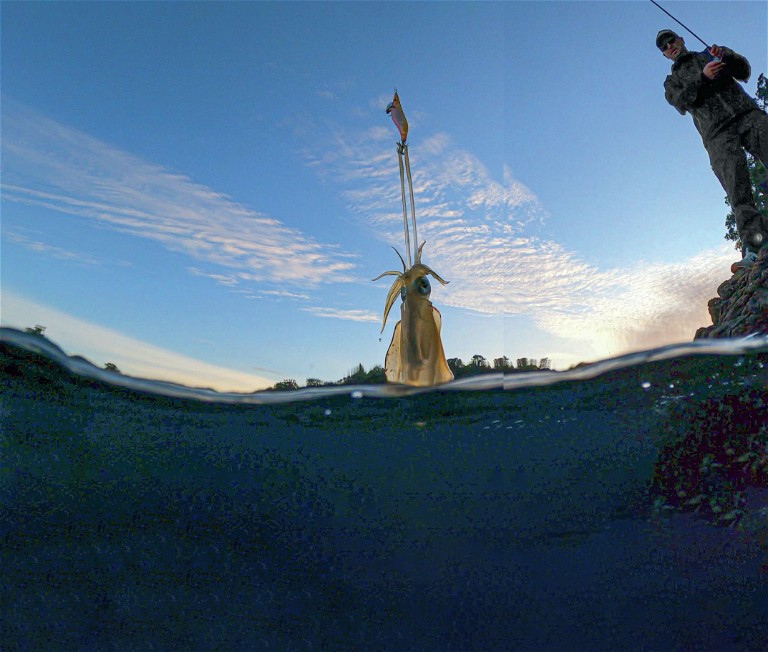
A few weeks ago, I set out on a mission – to go and catch a bunch of squid off the rocks, film it, and then produce a tutorial video all about squid fishing, the gear, and the techniques used.
There was just one problem, I had never fished for squid off the rocks before. The only squid fishing I had done was late at night, way offshore, on game boats where the squid are almost jumping into the boat. This project seemed more like ‘Mission Impossible’ the more I thought about it. Nothing like being thrown into the deep end, eh! Was I going to sink or swim?
Luckily for me, I had two very experienced squid fishermen with me: Johnny Pearce from Shimano NZ, and Dmitriy Kroll, a very keen squid fisherman with a decade of squid fishing under his belt.
I was going to call on them for advice, and at the same time try to get inside their heads and learn as much about squid fishing as I could from them (and film the whole experience).
It was early in the winter, the water was clear and chilling down day by day – the perfect time to target squid off the rocks in the upper North Island. With all this in mind and a few good fishing reports, we decided on a spot that was easy to get to and close to Auckland. It featured a nice rocky coastline with weed edges, was close to deeper water, and offered rocks that we could fish off with all tides.
I was starting the day with a crash course on squid fishing; in fact, to be 100% honest I had never even picked up a squid rod before this day! The night before our mission, my cameraman and I watched a few New Zealand squid fishing videos on YouTube to get a basic idea of what we were in for.
We met at our spot reasonably early in the morning and rigged the gear in the car park. I was all ears and eyes, excited, but at the same time watching Dmitriy and Johnny’s every move. I did not want to miss a thing and, luckily for me, they started from the beginning by sorting our leaders and connections.
The rods and reels specifically designed for squid fishing are 8’3” to 8’6” long, very lightweight, and have heaps of flex/whip in the tip to work the lures. The reels were a 3000 size, with a very shallow spool that holds 150m of 11-15lb braid. I was later to learn that the 3000-size spool is perfect for long casts and allows the line to be cast off the larger spool with a lot less friction than a narrower diameter spool.
Both boys connected the braid to either 11lb or 14lb Sephia fluorocarbon leader with a FG knot. This knot is nice and streamlined, casts well, and is very strong. The next cast was connecting the short 1.5m leader to the squid lure, and this was done by either a Rapala (Lefties) loop knot, or a uni knot to a small clip that could then be easily attached to the lure, making them easy to change during the session. So far, I was getting it all; the rigging was very similar to soft-baiting, and I could relate to everything they were doing.
I asked the boys what weight line and leader they preferred, and both come back with a similar answer. 11lb braid and leader for fishing in areas where there are not so many snags or rocks, and 14lb braid and leader for the rocky kelp areas. Today we were fishing in a rocky area, so we were all set up with a 14lb braided line and fluorocarbon leader. Like most lure fishing, fluorocarbon is a great choice for leaders: it’s less visible in the water, has a quicker sink rate that monofilament, and has great abrasion resistance for its diameter.
Johnny then pulled out a massive box of the new Shimano Clinch squid lures and this is where I got a little overwhelmed.
There were three sizes - #2.5, #3, and a bigger #3.5 – to choose from, and more colours than the rainbow. Where the hell was I going to start?

There was one thing they all had in common, and that was a pivoting foil built into the lure.
This technology is called ‘flash boost’ and it’s been in Shimano’s topwater lures for quite some time. The shimmering foil really brings the lure to life, and I would later learn how it triggers bites from squid.
I started quizzing Dmitriy and Johnny about lure choice and size.
The smaller the size, the slower the sink rate. Today we were only fishing in 2-4 metres of water, so a lighter #2.5 was the ideal choice. If there was a bit of current, then the #3 could be a better option, and the #3.5 was designed as a deepwater lure – ideal for fishing off the boat, or in areas with lots of current and deeper drop-offs.
They then both proceeded to talk about sink rates of the lures.
The smaller #2.5 sunk at about one metre every 4-5 seconds; the #3 around three seconds per metre; and the big #3.5 sunk at 1.5-2 seconds per metre. Being able to keep the lure in the zone and working it through the water column was going to be critical, and that advice really set the scene for me and gave me my first bit of confidence for the day.
So, now we had worked out that a size #2.5 was going to be perfect in this area, it was time to pick a colour. The sun was already coming up, so the boys all went for natural-looking bait presentations that looked like what the squid may be feeding on.
I picked out a colour that, to me, resembled a little jack mackerel and clipped it to my leader. Later, I would find out during the high sun that you should use more natural-looking colours, and then once the sun starts going down you should change to brighter colours, and then lumo/UV colours in the dark.
It was now finally time to hit the rocks. I walked along the rocky coastline with Dmitriy and quizzed him all the way about where to fish and what to look for in a good squid fishing spot. He mentioned that areas with weed and rocky coastlines are good. He also mentioned fishing right in the city on wharves and piers especially where there are lights on the shoreline that attract the squid.
We then got to spot number one, which had a nice flat rock that we could stand on and fan our casts out to cover a decent area. The water looked clean all the way out to a slight drop-off on the weed edge. It was a 30-metrelong platter of gradually slopping rocks and weed that then dropped off into a channel. “Perfect squid country,” I thought (and hoped).
I watched Dmitriy cast – wow.
Those lightweight rods could cast further than I thought! He waited for 6-8 seconds to allow the lure to drop down in the water column before he worked the lure.
When he did start to work the lure, it was like something I had never seen before – something like a cross between mechanical jigging, working a soft-bait, and horizontal jigging, all bundled into one technique. It included a pretty aggressive whipping motion with the rod to get the small lure to dart up and down and sideways in the water column, making it look like a fleeing or wounded baitfish. He would do roughly 3-4 movements, then stop and allow the lure to drop down in the water column. He’d do that over and over again as he worked the lure all the way back in, and then he’d cast again.
“Okay,” I thought, “here goes nothing!” I cast that #2.5 Sephia Clinch lure out and proceeded to copy what Dmitriy was doing until I got the hang of the technique.
I was only about 1/3 of the way working the lure back when:
BANG, I was hooked up! Yep, first cast and I was hooked to a squid.
Holy hell, what a start to the day!
Dmitriy looked over at me and I could tell by the look in his eyes that he was genuinely happy for me, but he was also laughing because it was 100% beginner’s luck!
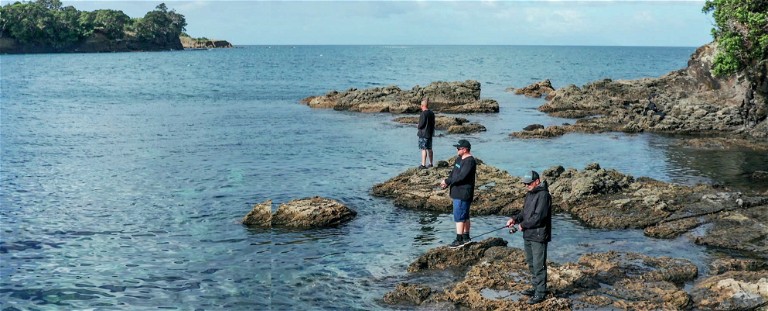
Finding the right territory to target squid is key to success.
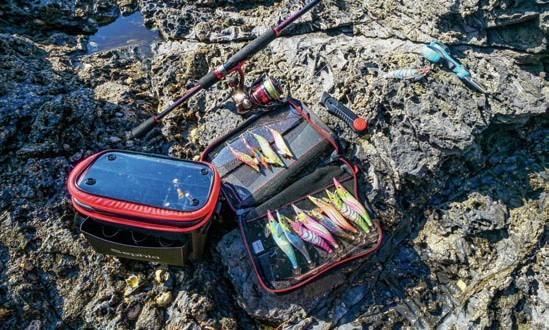
The range of lures available is mind-boggling.

There are specialist tools to deal to the catch.
This is where the carnage started. Ferdi, our cameraman, saw that I was hooked up and stopped flying the drone so he could get his camera rolling. Not long after Dmitriy also hooked up, we had a double on! So, Ferdi is now jumping carefully over the rocks with a camera that’s worth more than my boat under his arms, trying to get to us, and then, to make matter worse, it starts raining!
What a start to the day: two hookups in no time at all. This was going to be easy! Well, it wasn’t actually quite that easy.
We spent most of the rest of the day with no bites at all, until late in the afternoon when the squid came back on the bite again. The downtime during the middle part of the day was actually a great time to learn more from the boys, practice my techniques, and try to understand more about the gear that we were using.
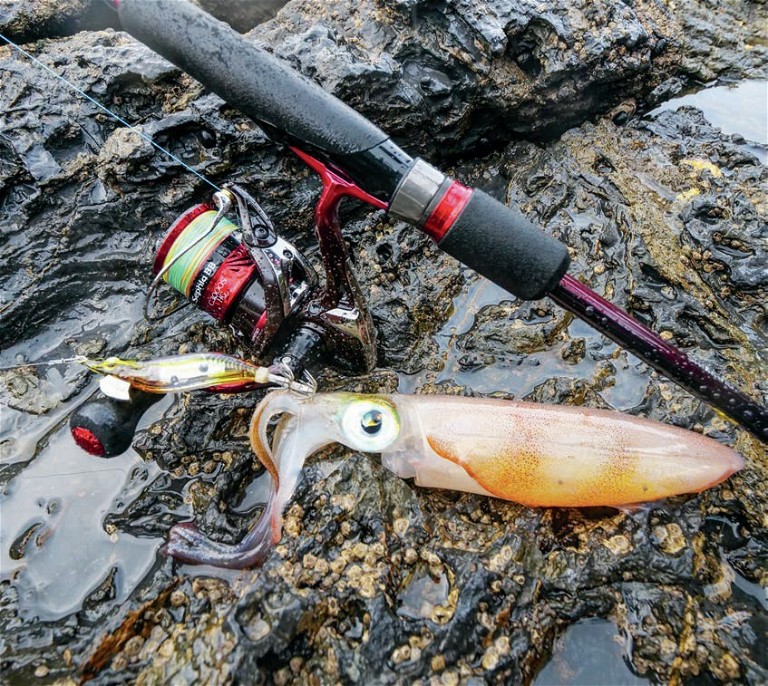
Shimano has developed a total squid fishing system, from rods and reels, to accessories and lures.
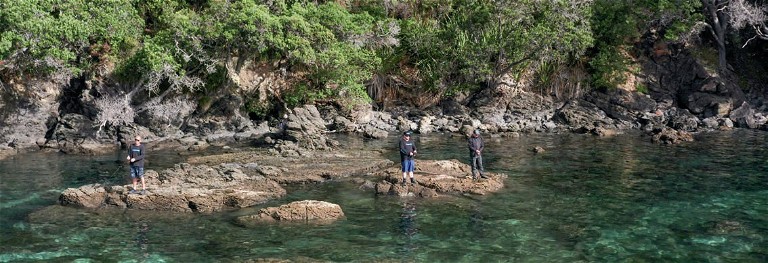
One thing that really impressed me is how Shimano has created a complete squid fishing system – from the braided line, fluorocarbon leader, specific reels, rods, and lures, right down to lure-specific cases and even an Iki stick made especially for dispatching squid. We used two different rod and reel combos from the Shimano range. The first was the high-end Sephia XR rod and reel combo, featuring the latest in materials and design (as you would expect from a flagship Shimano model), and a lightweight reel with great waterproofing and durability. The rod was super sensitive, crisp on the cast, and worked lures well. It also featured a full graphite butt for added sensitivity in detecting bites. I personally used the other stick, a Sephia BB, for most of the day, which is a great rod for even the most experienced and discerning squid fisherman.
So, in just one day I become a squid fisherman. I loved the experience, the setting, the adventure, and the thrill of trying something new. I am now looking for spots to go to near my home beaches, and it’s something that my family also want to have a crack at. This is a type of fishing that is easily accessible for most Kiwis and is also an affordable, clean way to fish. For me to get to spend the day on the rocks with two very experienced squid fishermen was an opportunity I could not pass up and definitely shortened the learning curve.
Thank you Dmitriy and Johnny for all the advice, experience, and patience you shared with me!
To see a video on our day squid fishing check out the following link: https://youtu.be/ViGlh8V4y7U Adios,
Tony Orton
